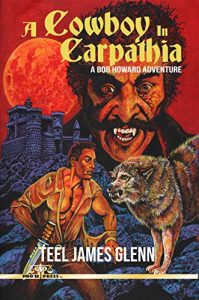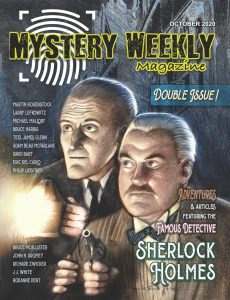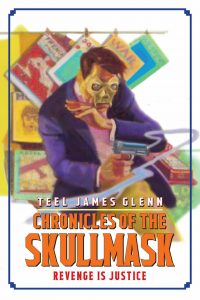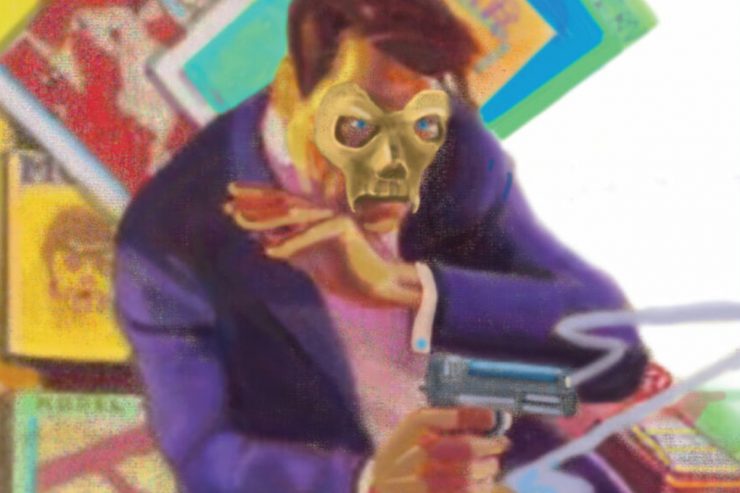Pulp magazines have influenced writers, artists, film directors, software developers, and countless others over the years. Our “PulpFest Profiles” focus on contemporary creators who have drawn inspiration from these rough-paper fiction magazines.
 Most authors spend their lives, well, writing. Teel James Glenn has inhabited multiple pulp lives. He’s been a stuntman, fight choreographer, swordmaster, jouster, illustrator, storyteller, director, bodyguard, and actor.
Most authors spend their lives, well, writing. Teel James Glenn has inhabited multiple pulp lives. He’s been a stuntman, fight choreographer, swordmaster, jouster, illustrator, storyteller, director, bodyguard, and actor.
And it all started in Brooklyn.
“I was a sickly kid,” Glenn explained to PulpFest. “I couldn’t do much. TV and movies, serials, and westerns were the things that really resonated with me. But I distinctly remember seeing chapter two of The Adventures of Captain Marvel. It was the first time I saw a superhero not made fun of. And the stunts were so impressive.”
For most pulp fans, watching would be enough, but that wouldn’t be much of an origin story, would it?
Glenn continued, “I said, ‘I have to do this.’ I got a super eight camera and I started making serials. I made several Rocketman serials, and, of course, Captain Marvel serials. Then I wanted to create original character serials as well.”
He knew that just winging it would not be satisfying. So he studied. “I had to learn how they did that stuff, so I read everything I could get my hands on, especially about stunts. I chased down any behind-the-scenes or making-of or how-to material I could find. And I rewatched everything, looking closely at how they set stuff up. I taught myself how to pad up. I actually used wash rags and ace bandages on my knees and elbows for my first stunts.”
Did the DIY method work?
Glenn laughed. “At fifteen, everything works. I couldn’t do anything in sports or anything like that. But you don’t need to have a lot of breath control to jump off of a garage roof, and fights for film are about 30 seconds long. So that was the beginning of it.”
“I went to art school to support my film and writing aspirations,” Glenn revealed with a laugh. “The day before graduation, I found out through a friend that someone was casting for a film. So I went. I got the lead and then found out they needed someone to set up the fight scenes, so I storyboarded them, and suddenly I was a professional.”
Though Glenn eventually studied under Errol Flynn’s last stunt double, he continued to learn his craft by doing. He acted and performed stunts in over 300 episodes of soap operas, most often on Guiding Light. He also fought Hawk in the crime drama Spenser for Hire, among other television appearances. Additionally, he battled across the independent cinema screen, performing stunts, acting, and at times directing in adventure, thriller, horror, and fantasy films set in various time periods throughout history as both hero and villain.
Whenever Glenn wasn’t diving through windows, sword fighting, and/or playing the heavy, he was writing.
 His facility with words came from another major revelation in Glenn’s life. “When I was fifteen, I had no heroes, I had no one. Then I was given Doc Savage and Tarzan and John Carter.” That led him to the work of Robert E. Howard, creator of Conan of Cimmeria, among other pulp heroes. “Howard has been a major influence on my writing.”
His facility with words came from another major revelation in Glenn’s life. “When I was fifteen, I had no heroes, I had no one. Then I was given Doc Savage and Tarzan and John Carter.” That led him to the work of Robert E. Howard, creator of Conan of Cimmeria, among other pulp heroes. “Howard has been a major influence on my writing.”
Robert E. Howard so influenced Glenn that he memorized the Texan’s poetry and analyzed his muscular prose, working them into his own writing voice. In fact, he found many of these pulp and genre stories not only inspired him to perform but also moved his pen as well. All of these experiences informed his writing.
From the soaps, Glenn learned, “You create the reality in that world, and for that reality to work, you need to believe it; you can’t wink at the audience.” No matter the genre, his writing commits to the reality of the story. “Everything I write, I see as a movie. I storyboard sets for my work, and I write scenes like I am choreographing for a stage play or a film.”
His characters get the same diligent development. “For every action scene, I ask, ‘Is it right for this character? Can he or she physically do it, or will that character be limping for the next three chapters?’”
And he never celebrates before the endzone. “I read every story out loud, and put it through a writers’ group,” Glenn said. “I have to know if it flows. I don’t want one extra ‘and’ or a run-on sentence. My characters cannot use technical terms they wouldn’t know or that didn’t exist in their time. Everything must fit the era, the setting, the character’s personality, or it will jump out of a story and ruin the reading experience.”
The result is a wide-ranging career that has produced a rich variety of tales about enough characters to keep a pulp fan reading for weeks.
 Glenn has been published in Mad Magazine, Fantasy Tales, Black Belt, Fantasy World Geographic, Mystery Weekly Magazine, Blazing Adventures, Tales of Old, Weird Tales, and dozens of other titles.
Glenn has been published in Mad Magazine, Fantasy Tales, Black Belt, Fantasy World Geographic, Mystery Weekly Magazine, Blazing Adventures, Tales of Old, Weird Tales, and dozens of other titles.
He has been praised for his longer fiction as well, now tallying two dozen published novels and novellas, plus anthology appearances.
In 2021, Glenn won the Pulp Factory Award for Best Novel, honoring A Cowboy in Carpathia. It’s built around the premise, “What if Robert E. Howard hadn’t died, and instead found himself confronting Dracula?”
Teel James Glenn has got that kind of mind, folks.
“I can’t think of another writer, besides maybe Lester Dent and Edgar Rice Burroughs, who has influenced me more,” Glenn explained.
A prequel short story — initially published in the Fight Card collection, The Bareknuckle Barbarian — was incorporated into the prologue of A Cowboy in Carpathia. In this story, Howard reads his poetry to his mother to comfort her as she passes. Then, instead of committing suicide, Howard uses the insurance money from his mother’s death to travel to New York and England “to meet real writers.” He also meets Boris Karloff and Gwendolyn Harker, which leads him into A Cowboy in Carpathia.
In many ways, the novel is a love letter to the pulps. To get the voice correct, Glenn had to write both prose and poetry in Howard’s style for his book.
Seeing A Cowboy in Carpathia honored has deeply impacted the author. “Other people put me up for (the award),” he said. “And winning was the best affirmation I could hope for.”
Glenn has a sequel to his award-winning tale coming out later this year from Pro-Se Productions. The Cowboy and the Conqueror finds the alternate reality Howard meeting a very different Adolf Hister (named after the Nostradamus prediction). They face off against a villainous Winston Churchill, who brings Cthulhu into their world. “And to really drive the historians nuts,” Glenn says with a mischievous smile, “eighty percent of the quotes are real, just out of context.”
Glenn recently reacquired the publishing rights to Murder Most Faire and is looking for the right publisher to re-release it. A murder mystery set at a Renaissance Fair, Glenn’s novel is the author’s most autobiographical work. He lost a close friend while they were running a medieval event. “About 75 percent of the book actually happened,” he told PulpFest.
 Chronicles of the Skullmask, a series of linked stories set in a variety of genres, has been re-edited into a collection that is out now from Bold Venture Press. It concerns a paranormal instrument of justice and has a very pulp-inspired feel.
Chronicles of the Skullmask, a series of linked stories set in a variety of genres, has been re-edited into a collection that is out now from Bold Venture Press. It concerns a paranormal instrument of justice and has a very pulp-inspired feel.
In a similar vein, Glenn’s Moxie/Maxie series blends crime and horror fiction in the fashion of Dime Mystery and the old shudder pulps. Moxie is a reporter and Maxie is a tough-as-nails actress. Together, they tend to find themselves mixed up with the profoundly weird.
“It’s The Thin Man meets The X-Files with a dash of Kolchak The Night Stalker,” Glenn explained. “No matter what happens, Moxie is grounded, until Maxie is in trouble. And he’s annoyed by monsters. One time he’s chasing a werewolf and comments, ‘My wife thinks I’m insane, and maybe I am, but I’m getting good copy.’”
The series drops many 1930’s names, both real and pulp fictional. “Maxie does a film with Bela Lugosi, and he remains a presence in their adventures,” he said. Reference is also made to Moxie covering Doc Savage’s exploits. And at one point, his heroes live down the street from another of Glenn’s characters.
That would be Dr. Shadows, a mix of Doc, The Avenger, The Green Lama, and The Shadow. His character is an adventurer who would be able to fight shoulder-to-shoulder with any of them. “There are oblique references to Dr. Shadows living in that same world,” Glenn said. “He borrows Doc’s plane, gets legal advice from Ham Brooks, and jumps into a cab driven by Moe Shrevnitz.”
When the editor of Blazing Adventures Magazine, Robert Spotted Pony Lee, suggested writing more contemporary stuff, Glenn wondered: “What if you are the son of a famous adventurer? That’s how Jon Shadows was created.”
The son of Dr. Shadows, Jon initially rejects his father’s legacy and joins the Marines. His experiences lead him to form the Shadows Foundation for Justice, with operatives all over the world. Now he tries to help mankind while living in his father’s shadow (pardon the pun), and that of his mother, a woman so badass she takes out an assassin at 85 years old. “She was the mean one,” Glenn laughed.
 Both Year of Shadows, featuring Dr. Shadows, and Killing Shadows, featuring Jon Shadows, are currently available. Jon Shadow’s next — Deadly Shadows — is due out by the end of 2021, while Dr. Shadows & the Hong Kong Horror is slated for 2022. They will both be published by Airship 27.
Both Year of Shadows, featuring Dr. Shadows, and Killing Shadows, featuring Jon Shadows, are currently available. Jon Shadow’s next — Deadly Shadows — is due out by the end of 2021, while Dr. Shadows & the Hong Kong Horror is slated for 2022. They will both be published by Airship 27.
Like Indiana Jones, when he’s not adventuring or chronicling adventures, Glenn teaches. He’s a swordwork instructor in New York. He also lectures and leads seminars and workshops on writing action scenes, sword-fighting, gun-handling, and choreographing fight scenes at various conventions including StokerCon and Deadly Ink.
And he’s still rolling out yarns. Glenn has a short story featuring his occult detective, Doctor Argent, in Cirsova Magazine for Fall 2021. Another short story, “Bargain of the Bard,” is in the September issue of Sword & Sorcery Magazine. His zombie tale, “Popping the Cork,” appears in the Angry Eagle Press anthology, Run from the Dead, published in late September. A collection of Doctor Argent tales, Sempre Occultus, came out from Pro Se in September as well. There is also a Dr. Watson short story for Mystery Magazine’s October issue, while Dragonthroat — a sword & sorcery/fantasy novel set in the world of Ativa — is planned for release by Airship 27 this fall. Glenn has been writing stories set in Ativa for fifty years. His novel Call Down the Lightning focuses on an Afghan vet with PTSD who works in a haunted house. It is currently on the market.
Why has such an explosion of productivity followed his best novel award? Glenn suggested that such kudos come with a price. “Now I have to be good,” he acknowledged with a grin, “I can’t fail those who showed faith in me. To know that I do this well enough that people find it satisfying is an incredible gift.”
Onward charges the urban swashbuckler, with an output that honors the pulp writers who originally inspired him.
To learn more about Teel James Glenn — winner of the 2012 Pulp Ark Award for Best Author and the Pulp Factory Best Novel Award, Epic ebook award finalist, P&E winner Best Thriller Novel and Best Steampunk Short, multiple finalist for the Best Fantasy Short Story and Best Fantasy Collection, and a member of the HWA, MWA, HNS, and ITWA — please visit theurbanswashbuckler.com.
Christopher Ryan has been an award-winning journalist, teacher, podcaster, actor, producer, and director, but mostly he writes fast-paced stories with humor and heart. You can learn more about Christopher and his work at www.chrisryanwrites.
To learn more about both of these guys, join Christopher — along with author Alex Simmons — on episode 210 of TELL THE DAMN STORY. Christopher’s and Alex’s podcast has been airing since 2015. You can tune in on Apple Podcasts, Pocket Cast, Spotify, YouTube, or other podcast platforms.
THE ADVENTURES OF CAPTAIN MARVEL — a twelve-chapter movie serial — was released in 1941 by Republic Pictures. The second chapter was entitled “The Guillotine.” The poster artist is not known.
Teel James Glenn’s award-winning A COWBOY IN CARPATHIA: A BOB HOWARD ADVENTURE was published in October 2020 by Pro Se Productions and features cover art by Larry Nadolsky.
A Basil Rathbone and Nigel Bruce cover painting — executed by Robin Grenville-Evans — adorns the October 2020 issue of MYSTERY WEEKLY MAGAZINE. It’s a double issue featuring articles and stories concerning Sherlock Holmes and Doctor Watson, including Tell James Glenn’s “The Adventure Of Sherlock Hominid.” Glenn’s story features a talking chimpanzee who uses deductive reasoning to solve a locked room murder à la Sherlock Holmes.
CHRONICLES OF THE SKULLMASK: REVENGE IS JUSTICE — published by Bold Venture Press in April 2021 — is inspired by the great heroes of genre fiction, as well as the weird-menace pulps. The cover design is by the author, Teel James Glenn. Likewise inspired by the great heroes of genre fiction, JON SHADOWS: KILLING SHADOWS — published by Airship 27 in March 2021 — is a contemporary take on the pulp novel. The cover art is by Rob Davis.







